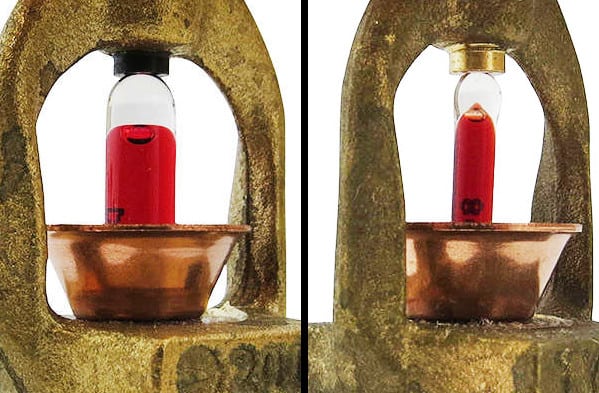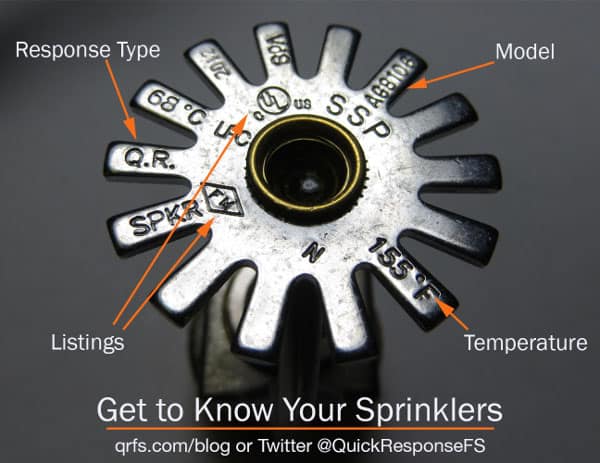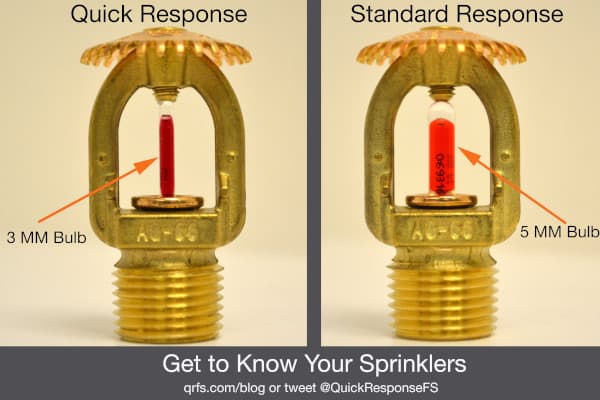Quick response sprinklers have a slightly different mission than standard response sprinklers
In 1996, NFPA 13: Standard for the Installation of Sprinkler Systems started requiring quick response or other fast-response fire sprinklers in all new systems installed in light-hazard occupancies. As a result of this change, most newer office buildings, restaurants, hotels, and schools now employ quick response heads instead of the traditional standard response models. But what is the difference between a quick response and standard response fire sprinkler?
In this blog, we explore the slightly different missions of standard versus quick response models and how to tell them apart with ease. And if education isn’t the reason for your visit today, feel free to skip directly to our online selection of fire sprinklers.
Six fire sprinkler characteristics — and the big changes in quick response vs standard response sprinklers
Since Henry S. Parmelee invented the first automatic fire sprinkler in 1874, the goal of delivering water exactly where it is needed — as early in the fire’s development as possible — continues to drive innovation in the fire sprinkler industry. But many of the challenges that Parmelee faced in his piano factory differ from those of a modern high-rise building, warehouse, or university brimming with students. In response to these unique fire hazards, engineers have developed different types of fire sprinklers.
Six primary aspects of a fire sprinkler impact its usefulness for various buildings and settings:
- Thermal sensitivity
- Temperature rating
- Orifice size
- Installation orientation
- Water distribution characteristics
- Special service conditions
Most of these options, including temperature, orifice size, and orientation, are available for both quick and standard response sprinklers. The key differentiator between them is thermal sensitivity; how sensitive the sprinkler’s heat-sensitive element is to its activation temperature. This sensitivity is measured through a sprinkler’s response time index (RTI) and falls into two main categories:
- Fast Response sprinklers have an RTI of 50 or fewer meters-second1/2 (90 or less (ft-sec)1/2)
- Standard Response sprinklers have an RTI of 80 or more meters-second1/2 (145 or more (ft-sec)1/2)
Fast response and quick response may sound like the same thing, and that idea is half right. Quick response is a type of fast response sprinkler — a subclassification — that is typically applied to most commercial sprinklers that have a fast response element. Residential sprinklers are another type of fast-response sprinkler and are often described that way. So are Early Suppression Fast Response (ESFR) sprinklers, which are used in special storage applications. So the three most common fire sprinklers include:
Standard response fire sprinklers can be found in warehouses, factories, and other commercial or industrial buildings. A standard response sprinkler’s mission is to pre-wet materials around the fire, removing its fuel source. Drenching the surrounding area slows the fire, buying critical time for the fire department to get on the scene. Containing the fire in its original location and suppressing its growth are the focus.
Quick response fire sprinklers are a type of commercial fast response sprinkler installed primarily in light-hazard applications (e.g., office buildings, schools, etc.). They have similar fire-control benefits as a standard response sprinkler, but their mission is slightly different. A quick response sprinkler goes off faster, prioritizing occupant escape and life safety.
Residential fire sprinklers (fast response) are used in, you guessed it, residential applications, often single-family homes. They have a similar priority to quick response sprinklers — human survivability and escape — plus unique deflector patterns and droplet sizes that use water efficiently in a home system, where water may be at a premium. They discharge water higher on the walls to keep the fire from climbing and maintain lower ceiling temperatures. Cooler ceilings reduce the likelihood of flashover and slow a fire’s growth within a building. Again, improving the odds of human survivability is the residential (fast) response sprinkler’s primary mission.
Quick response and other types of fast response sprinklers got their name from their faster response time when compared to standard response sprinklers, of course. And the only physical difference that allows them to do this is the size of the liquid-filled glass bulb that serves as the heat-sensitive element. A standard response sprinkler has a 5 mm glass bulb and a quick response sprinkler has a 3 mm glass bulb. The latter bulb’s smaller size speeds up thermal responsiveness.

Differences also exist in spacing, density, and placement of sprinklers within a quick response system compared to a standard response system, and residential systems vs. the other two. These changes combined with the smaller bulb, water spray patterns, and more are all designed to support the individual sprinkler type’s mission.
So which do you need? The answer depends on your project, system, and building, and whether the system is new or sprinklers need replacement
Ceiling height, ambient room temperature, occupancy status, hydraulic design, and more items all factor into what type of sprinkler is the best fit for any given situation. If you’re constructing a new building, hire a local, qualified fire sprinkler contractor with a dedicated design team. Their staff will know what is needed and tailor the system and sprinklers to your building and what it’s used for.
If you’re replacing fire sprinklers in an existing system — and the building’s use and what it stores (the fuel hazard) hasn’t changed — it is standard practice to find an exact replacement for the old fire sprinkler. So here’s a trick so you can use today: on most fire sprinklers, all the information is stamped on the deflector. Just get up close and take a look for yourself, as in the image below:

For more information about replacing fire sprinklers, read our handy identification and replacement guide. If you’re still unsure about what type you need or your sprinkler’s deflector doesn’t have the details, then call or write QRFS — customers even text us pictures to help them identify their sprinklers and get replacements ordered!
It’s important to note that both types of fire sprinklers have specific areas of coverage and control fire hazards per NFPA 13 rules. Regardless of their slightly different missions, both are firefighting superheroes that save lives and property.
Browse QRFS’s fire sprinkler selection.
This article was originally posted on January 14, 2013, on QRFS.com by Jason Hugo. It was updated on August 18, 2022. If you’d like to learn more, read more articles from Thoughts on Fire, QRFS’s ever-expanding knowledge center, tweet with us @QuickResponseFS, or connect on Facebook.



Is this information correct?
Standard Response sprinklers have an RTI of 50 or fewer meters-second1/2 (90 or less (ft-sec)1/2)
Fast Response sprinklers have an RTI of 80 or more meters-second1/2 (145 or more (ft-sec)1/2)
Jan — It was not correct — the labels were reversed (a typo) — and we have corrected it. THANK YOU for the eagle eye and comment!
RTI 50-80 (ms) ½
Special Response has been established as a classification in Europe for selected fire risks and sprinkler types in accordance with VdS 2160 and ISO 6182-1 standards.
Is that right?
Eugene — We assume you found that at this source from a German manufacturer. Unfortunately, we are not current on those European standards and how they treat this classification.
Hi,
this part of your explanation above is not correct…
Quick response fire sprinklers are installed primarily in light-hazard applications (e.g., office buildings, schools, etc.). They have similar fire-control benefits as a standard response sprinkler, but their mission is slightly different. A quick response sprinkler discharges water higher on the walls to keep the fire from climbing and maintain lower ceiling temperatures. Cooler ceilings reduce the likelihood of flashover and slow a fire’s rise within a building. Improving the odds for human survivability is the quick response sprinkler’s primary mission.
The response rating of a sprinkler has nothing to do with “discharging higher up the walls” in Light Hazard. This is only true of residential sprinklers. Fast response light hazard and ordinary hazard sprinklers are exactly the same item, with differing spacing criteria. The deflector shape, orifice size and operating pressure determine the spray pattern., whether fast or standard response.
Daniel — You are correct. Our apologies; we suspect we accidentally transposed/applied the sentences within that section incorrectly. We have corrected this post—thank you! Note: we’ve covered this more accurately in a more recent blog:
“First, the QR and standard response versions of a similar model of sprinkler have the same deflector. When it comes to spray patterns, they are identical. They deliver whatever mixture of small, medium, and large droplets in an umbrella pattern designed to provide comprehensive wetting. […] Residential sprinklers have a broader, higher spray pattern along with that different droplet size. This design prioritizes wall-wetting and was developed to enhance survivability for residents who may have a limited water supply.”
Thank you again for bringing this to our attention, and thanks for reading!